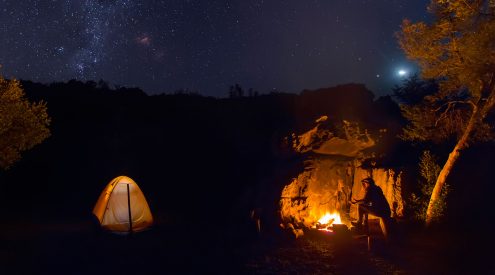Five days in the bush. I couldn’t resist the invitation to join my friends at Nkelenga, a lovely self-catering camp in the Thornybush Game Reserve.
The bush was verdant and very lush, but the weather didn’t play along and it was raining when we arrived. It continued to rain on our first game drive. Despite the lodge-provided ponchos some of us still managed to get wet. In a moving vehicle you get cold quite quickly and some became miserable in this weather.
At night I found the sound of little raindrops on the tents a soothing lullaby and slept fitfully. A day later, the rain eased. The clouds remained but at least we weren’t wet. Sunny skies returned the afternoon before our visit was over and we enjoyed an African sunset without which my visit to the bush would have been incomplete.
Our dedicated father-son team Joe, the ranger and Vusi, our tracker were engaging and pleasant. Joe has been working on the reserve for 18 years and knows the area intimately. He broke into a huge smile when we found an uncommon summer visitor, a thickbilled cuckoo. A birding “˜lifer’ for both him and me.
The animals weren’t bothered by the inclement weather and we had some of the loveliest sightings on our game drives, which, after all is the reason most people visit the bush. From the deep soulful resonant calling of a male lion, itchy buffalo, frolicking black rhino and close up elephants, we saw plenty.
As there has been so much rain on the reserve, off road driving was limited. Fortunately, our sighting of mating leopards was in a dry area so we could bush-bash to watch it. The fast act happens in a blur of spots. I can’t explain the vicious sound of hurt and growling snarls the female makes when the male withdraws his barbed penis after copulation.
We ticked off the obligatory big five sightings and then tried to find the small five, only succeeding in finding the rhino beetle, the red-billed buffalo-weaver and the leopard tortoise. I think the ant lions must have drowned in mud and the elephant shrews opted to stay dry in their burrows.
In these times of heightened environmental awareness, I sat on the vehicle during one drive thinking of the carbon footprint I was making to satisfy my “˜bush-fix’: the drive from Joburg and then the twice-daily game drives. I admit I can’t come up with a solution to experience any of this magnificence from my apartment balcony in Joburg. Nothing beats the real thing.
What’s in a name?
Nkelenga is the Tsonga word for Fever Tree (Acacia xanthophloea) and some lovely large, thorny specimens surround the lodge. The genus name Acacia is derived from the greek word “acantha”: meaning spine, thorn or prickle and the species name xanthophloea is derived from the greek words “xanthos” meaning yellow and “phloios” meaning bark.
Medicinally, the bark is used for treating fevers and eye complaints. Early settlers thought that this tree caused a fever as people living or travelling in the areas where it grew contracted a bad fever. They incorrectly associated the fever with the tree, as the swampy, wet places where fever trees grow are also ideal breeding grounds for malaria-carrying mosquitoes.
















